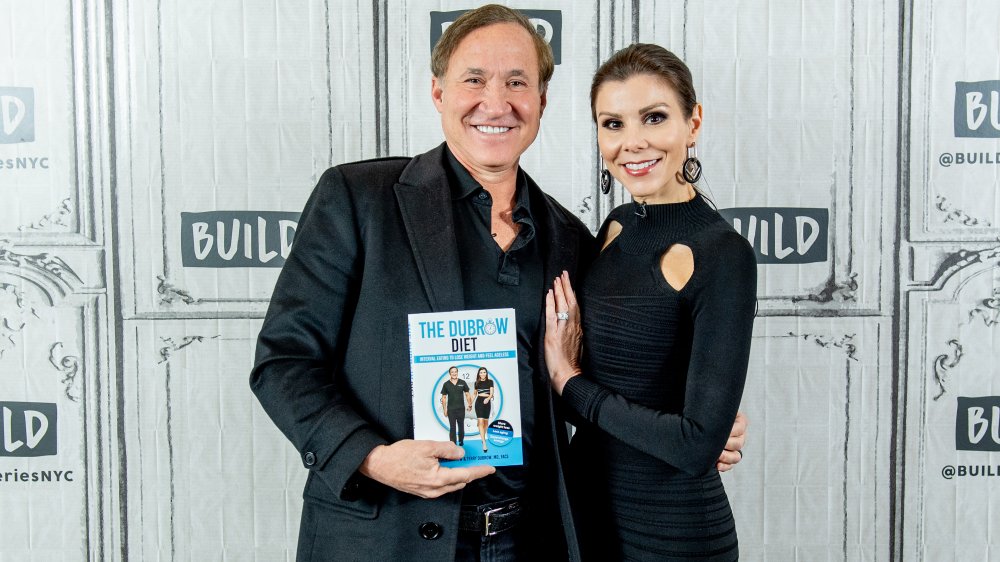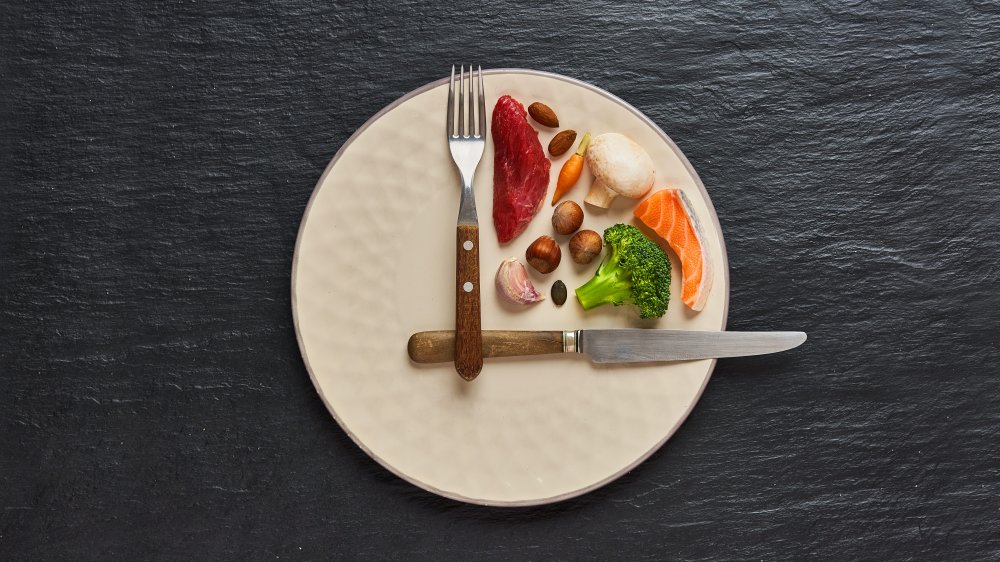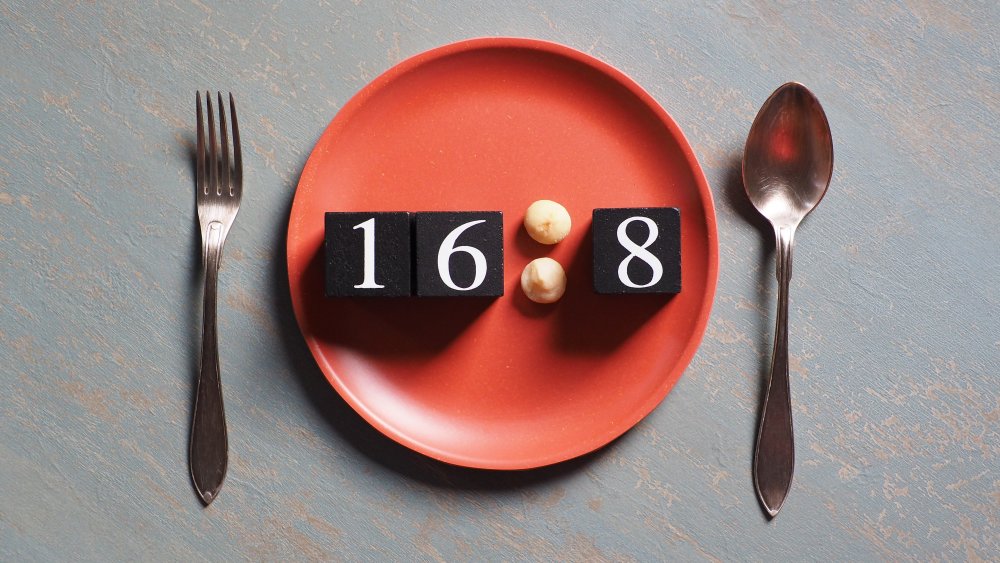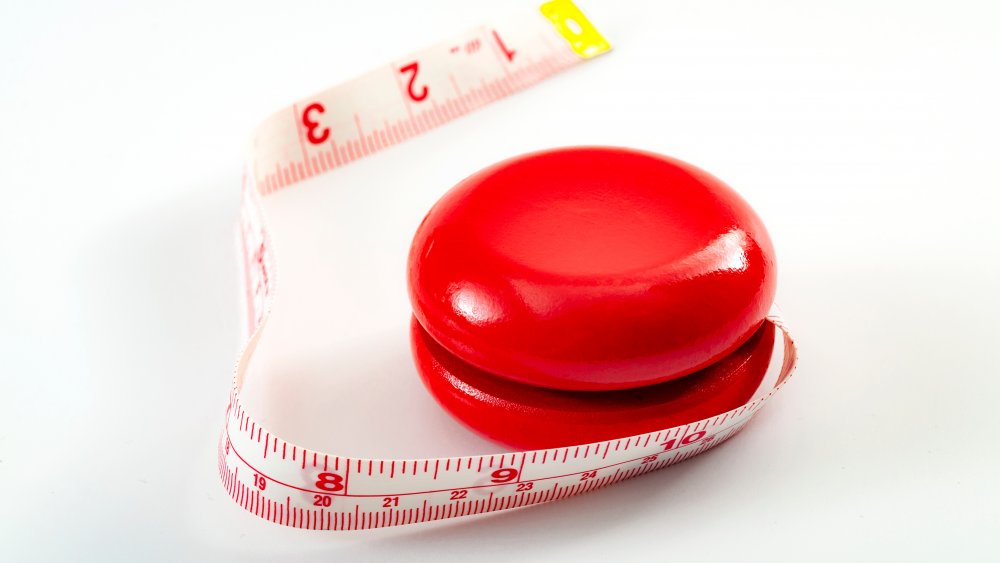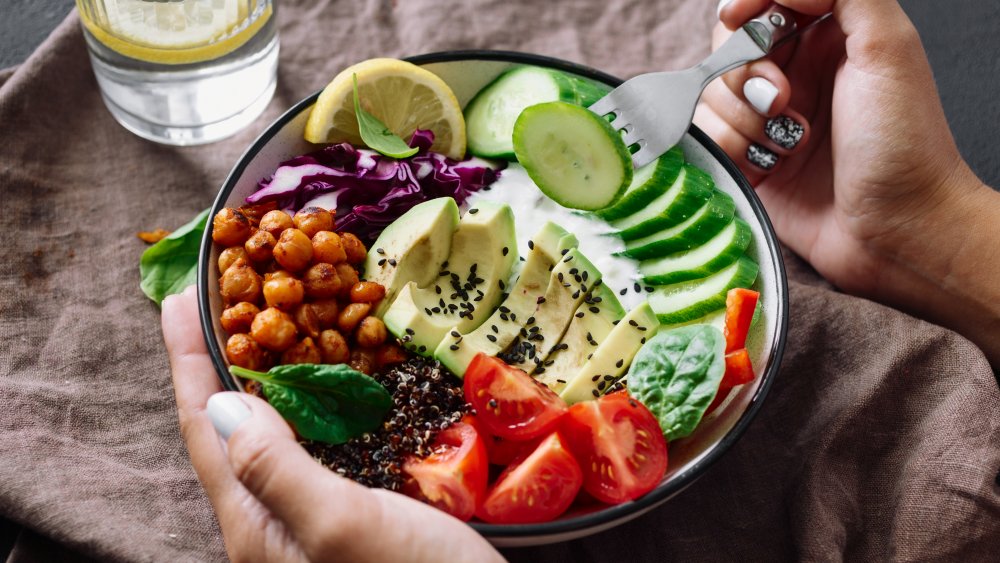The Truth About The Dubrow Diet
We may receive a commission on purchases made from links.
The Dubrow Diet, an eating plan and popular book created by former Real Housewives of Orange County star Heather Dubrow and her husband Terry Dubrow, a plastic surgeon and former Botched co-host. Influencers and reality TV stars have been marketing diet and fitness plans on social media and elsewhere for years, of course, but not many have managed to catch on quite like the Dubrow Diet.
Before we get into the details of whether or not the Dubrow Diet is safe or worth trying, here's what you need to know: It's more comprehensive than a basic macro-counting plan you might find another influencer advertising on Instagram. The couple cites bits of research throughout their book and gives very specific instructions for what to eat, what not to eat, when to eat, and how much to eat.
The Dubrows call their diet an "interval eating" plan and claim that it can improve your blood sugar control, promote weight loss, boost your energy, and slow the signs of agin on your body. But, is it legitimate?
The Dubrow Diet is based on intermittent fasting
The Dubrows label their diet as interval eating, which is really just a fancy way to say that it's based on intermittent fasting. You've probably heard of intermittent fasting, as it's one of the most popular diets around right now. The idea behind it is fairly straightforward: You eat all of your meals and snacks in a set window of time each day and "fast" (avoid eating or drinking anything with calories) for the rest of the day.
The intermittent fasting framework can take many forms, but the most popular and simplest form is the 16/8 format, in which you eat for eight hours a day and fast for 16 hours. In practice, that might mean fasting from when you wake up until noon, then eating during the afternoon and evening and stopping at 8 p.m. Alternatively, you could choose to start eating at 2 p.m. and stop at 10 p.m., or start at 9 a.m. and end at 5 p.m. (via Healthline).
The Dubrow Diet suggests different fasting schedules during different phases of the diet, which we'll get into below. But, as long as you're on the Dubrow Diet, you'll follow some form of intermittent fasting.
This is why the Dubrow Diet may be flawed
Although the Dubrow Diet calls for a form of intermittent fasting, intermittent fasting in and of itself is popular. Although many people report seeing benefits after this style of fasting, most of the research in this area has been done on rodents. In other words, there haven't been any studies done to test whether or not the Dubrow Diet actually does what it claims that it can do.
"To date, there is much debate around the concept of intermittent fasting and weight loss and there is uncertainty as to whether it's the fasting or the calorie restriction that leads to weight loss," registered dietitian Toby Amidor wrote in a 2019 article for Food Network. If fasting doesn't work for you, you'll probably get the same benefits from eating the same amount of food over a longer timeframe. Unfortunately for fans of the Dubrow diet, in particular, Amidor revealed that it lacks "scientific merit."
There are three phases to the Dubrow diet, with the first phase being the most restrictive
The Dubrow Diet takes you through three phases, a format that's common among popular weight loss diets. The first phase is what the Dubrows dub the "Red Carpet Ready" phase, according to Good Housekeeping, and it's the most restrictive of all three phases.
During this first phase, you follow the 16/8 formula of intermittent fasting, eating for 8 hours and fasting for the remaining 16 hours. On top of that, there are very specific instructions on exactly what you should eat during your 8-hour window. In their book, the Dubrows suggest consuming two to three servings of 3 or 4 ounces of protein, one to two servings of fat, one serving of nuts or seeds, one serving of dairy or a dairy alternative, two to three servings of "above ground" vegetables, one serving of fruit, one serving of complex carbs, and one savory "treat" (via Good Housekeeping).
All such foods — from protein types to treats — must be on the Dubrows' list of approved foods, which are outlined in the couple's book. The Dubrows recommend staying in this phase for two to five days, depending on how much weight you hope to lose.
The second phase of the Dubrow Diet is about continuing weight loss
Phase two of the Dubrow Diet is the "Summer is Coming" phase, according to Good Housekeeping. You have the option of a 12-hour, 14-hour, or 16-hour fasting window, depending on how much weight you hope to lose. The longer you fast, the more quickly they say you will lose weight. Dieters are to follow this phase until reaching their respective goal weights.
There are also strict dietary guidelines for this phase. Just like in phase one, the Dubrows recommend eating (in accordance with their approved list): two to three servings of 3-4 ounces of protein, one serving of nuts or seeds, one serving of dairy or a dairy alternative, one serving of complex carbs, and one savory treat.
During this phase, you'll also increase your fat intake to two to three servings and your fruit intake to one to two servings — from the approved list, of course. Your vegetable choices also expand from just above-ground vegetables in phase one to all vegetables in this second phase — that means root vegetables (beets, carrots, squash, et cetera) that grow in the ground are now on the table. You can also have a libation or two per day.
The third phase of the Dubrow Diet is the maintenance phase
Once you've reached your "goal weight," the Dubrow Diet isn't over. In fact, the Dubrows recommend following their third and final phase, "Look Hot While Living Like a Human," forever — which is a lot to ask for any diet. It is significantly less restrictive than phases one and two.
Although you do fast for 12 hours per day five days a week, and 16 hours a day two days a week, there aren't any specific rules around what you should and shouldn't eat; no approved food lists, no suggested portion sizes, and no recommended amounts of various foods (via Good Housekeeping).
This third phase is certainly more sustainable than the first two phases, which frankly sound like they take a lot of thinking and planning ahead. However, this phase doesn't totally let you off the hook. In addition to sticking to the Dubrows' recommended intermittent fasting schedule in perpetuity during the third phase, the Dubrows also recommend that you go back to the previous phases if you start gaining weight. That means back to the restrictive rules and limited eating hours of phases one and two.
The Dubrows diet doesn't require calorie counting, but it still requires work
One thing that's very frustrating and arguably a little bit sneaky about the Dubrow Diet is that it's billed as a simple alternative to macronutrient (carbs, protein, and fat) tracking or calorie counting. That's sort of true; the diet doesn't require you to add up calories or track the macros of every food you eat. However, the diet does give very explicit and strict instructions on exactly how much to eat of each recommended food.
While you can probably eyeball portions without breaking out a food scale or a measuring cup, you still will have to put a lot of energy into making sure you're eating exactly the amount of food that the Dubrows recommend in their book (via NBC News). "Based on the meal plan advice, the calories are quite low in the first two Phases of the program — lower than most health experts would recommend, and lower than what you'd likely need to sustain energy levels and meet nutrient needs," wrote registered dietitian Samantha Cassetty in an article for NBC News.
The Dubrow Diet doesn't just promise weight loss
In addition to the obvious weight loss claims of the Dubrow Diet — and pretty much every diet, for that matter — the Dubrows make a few other pretty significant claims on HeatherDubrow.com. They claim that the diet can "activate a process known as autophagy, your cells' self-cleaning process and an antiaging game changer."
The Dubrow Diet is not the first diet to claim this benefit; most proponents of intermittent fasting cite autophagy as a potential benefit. The problem? Scientists still aren't sure whether or autophagy is a significant contributing factor to slowing the aging of cells or fighting off disease in humans, as most of the studies done in this area have been done on rodents, according to Medical News Today.
Additionally, autophagy is constantly occurring in our bodies, so it's not like you need to do anything in particular to make it happen. It's possible that fasting might trigger autophagy, but again, most of the research done in this area has been conducted in animals. The research is quickly developing, but it's too soon to make conclusions, as of this writing.
The Dubrow Diet may help you temporarily improve our cholesterol
Could the Dubrow Diet offer any health benefits besides weight loss? Possibly, but perhaps not in the long term. Because the Dubrow Diet is relatively new and lacks scientific studies, it's impossible to say whether the Dubrow Diet specifically has unique health benefits (although experts think it's unlikely). However, there have been studies done on intermittent fasting, the larger framework that the Dubrow Diet fits into.
One 2017 review study published in the Annual Review of Nutrition found that while there aren't many studies out there that look at how intermittent fasting affects humans, there is evidence that eating just one or two meals a day instead of the traditional three meals can lower LDL (bad) cholesterol and raise HDL (good) cholesterol. However, the authors noted that none of the available studies on intermittent fasting lasted for more than six months, so it's impossible to say whether this benefit lasts long-term.
You might give up on the Dubrow Diet after a little while
As the Dubrow Diet is based on intermittent fasting, it's not immune to a problem that plagues this eating style: The dropout rate is really high. People can follow the specific eating and fasting schedule for a few months, but then life starts to get in the way and the diet is abandoned. One review published in Current Obesity Reports revealed that up to 40 percent of people who try intermittent fasting end up quitting.
To be fair, the same thing is true for diets that restrict calories but didn't restrict when dieters could and couldn't eat. So intermittent fasting isn't necessarily any harder to follow than a low-calorie diet — but it also isn't any easier to follow. And since the Dubrow Diet is both an intermittent fasting diet and a low-calorie diet, you could reason that dropout rates can climb even higher, though that remains to be seen.
If you've tried any kind of diet before only to give up after a couple weeks or months, it's likely that the Dubrow Diet won't hold your attention for long. It's more restrictive than many other diets out there, after all.
Constantly stopping and starting a diet like the Dubrow Diet can have negative health effects
Maybe you're thinking, "I'll give the Dubrow Diet a try. If it doesn't work, I'll try something else instead." That's a common thought. Many people jump from diet to diet, losing weight and regaining it, then trying another diet only to lose and regain the same amount of weight. In fact, preliminary research from the American Heart Association (AHA) found that 73 percent of women reported at least one episode of yo-yo dieting — losing and regaining at least 10 pounds within a year by dieting — in their lifetimes, and some women reported doing this up to 20 times.
Losing and regaining weight is frustrating, of course, but it's also bad for health. The AHA research also found that yo-yo dieters were 82 percent less likely to have a "healthy" body mass index and had worse health overall compared to those who did not yo-yo diet. More research needs to be done on the longterm effects of yo-yo dieting, but it's a good idea to avoid any kind of unsustainable or crash diet.
The Dubrow Diet book focuses heavily on aesthetics, not health
All it takes is a quick glance at the titles of the Dubrow Diet phases — "Red Carpet Ready," "Summer is Coming," and "Look Hot While Living Like a Human" — to realize that the diet is heavily focused on achieving a certain "look." And sure, it's natural to want to look a certain way given the weight-obsessed, wrinkle-fearing culture we live in. But an obsession with looks isn't healthy at all.
"This diet plan is heavily focused on physical appearance, which does not always equal health, and undermines self-acceptance and body positivity," registered dietitian Melissa Nieves told Insider. "Plus, its focus on being bikini ready and looking good does not support long-term, healthy lifestyle changes," she continued.
Two people could eat exactly the same way for years and still look different. Just because you follow the Dubrow Diet, that doesn't mean you'll look exactly like Heather Dubrow or another thin celebrity or influencer. And, as Nieves said, constantly pursuing thinness can wreak your self-esteem and drive you to become overly restrictive with food, which is the opposite of healthy.
The Dubrow Diet paved the way for the Dubrow Keto Fusion Diet
As if the original Dubrow Diet isn't restrictive enough, the Dubrows came out with another approach, which was published in their March 2020 book The Dubrow Keto Fusion Diet: The Ultimate Plan for Interval Eating and Sustainable Fat Burning.
On this updated plan, dieters follow a 12:8:4 eating schedule: 12 hours of fasting, eight hours of eating high-fat and very low-carbohydrate foods, and four hours of eating low glycemic index fruits and vegetables as well as high-fat and high-protein foods. The Dubrows claim that this framework gives you the benefits of both the keto diet and intermittent fasting, and leads to fast weight loss (via Parade). However, there's really no evidence to say whether or not this is true.
Plus, any possible benefits of following a keto diet (weight loss and improved blood sugar control) may be offset by potential risks, including digestive issues, increased risk of chronic disease and early death, poor bone health, nutrient deficiencies, and stress on your kidneys (via Healthline). In addition to the risks, the Dubrow Keto Fusion diet is likely unsustainable for most people since it considers so many foods off limits.
If you're absolutely set on trying the Dubrow Diet, dietitians recommend making modifications
Frankly, there are some good reasons not to try the Dubrow Diet. It's overly restrictive and it lacks real science to support its claims of boosting weight loss or improving health. However, dietitians do admit that the diet's focus on nutritious foods like fruits, vegetables, nuts, seeds, healthy fats, and lean proteins is a good thing.
If you really want to try the Dubrow Diet, first modify it to fit your own unique needs. "When it comes to diets, there is no 'one size fits all,' but you certainly do need to take in all the nutrients that your body needs," wrote registered dietitian Toby Amidor in an article for Food Network. "If you do choose to follow the Dubrow Diet, make sure to take in more fruits, dairy and complex carbs than outlined in the book." And if you find that you're irritable, hungry, tired, or just unhappy on the diet, quit following it and find an eating pattern that works for you.

